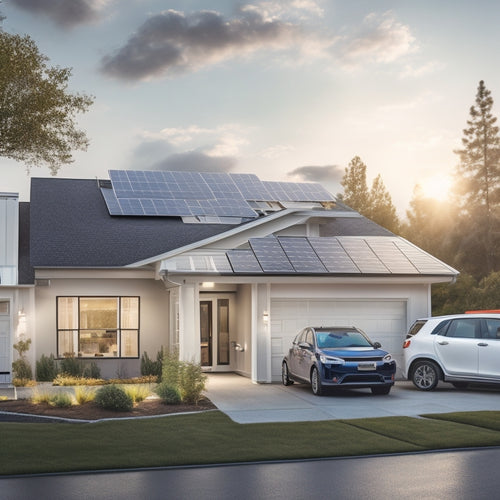
What's the Total Cost of Solar Panels and a Battery System
Share
When calculating the total cost of solar panels and a battery system, you'll need to take into account several key components. The cost of solar panels, type and capacity of the battery system, installation and labor costs, inverters and charge controllers, mounting and tracking expenses, permits and inspection charges, and ongoing maintenance expenses all play a role. These factors can vary widely, with prices influenced by system capacity, battery technology, installation complexity, and more. As you investigate your options, understanding each of these components will help you make an informed decision - and getting a clear visualization of your total costs will be just the starting point.
Key Takeaways
- The total cost of solar panels and a battery system includes equipment, installation, and labor costs, which can vary depending on system size and complexity.
- System capacity, battery type, and installation complexity significantly influence overall costs, with larger systems and lithium-ion batteries being more expensive.
- Inverter and charge controller fees, mounting and tracking expenses, and installation labor costs add to the total expense, ranging from 10% to 30% of the total cost.
- Financing options, government incentives, and long-term energy savings can help offset upfront costs, making solar panels and battery systems more affordable.
- Ongoing maintenance expenses, including battery health checks and inverter replacement, should be factored into the overall cost of owning a solar panel and battery system.
Solar Panel System Costs Breakdown
The total cost of a solar panel system includes several components, each with its own price tag. When calculating the total cost, you'll need to take into account the solar panels themselves, inverters, mounting hardware, and installation labor.
Additionally, you may be eligible for solar incentives, such as tax credits or rebates, which can greatly reduce the upfront cost. Financing options, like loans or power purchase agreements, can also help make solar more affordable.
Over time, you'll benefit from energy savings, reducing your reliance on the grid and minimizing your environmental impact. With grid independence, you'll have more control over your energy costs.
Be sure to also take into account system warranties, installation timelines, and technology advancements when making your decision. By understanding these factors, you can make an informed decision about investing in a solar panel system.
As you research, consider the experiences of other homeowners who've already made the switch, and stay up-to-date on the latest market trends to get the best deal possible.
Battery System Price Factors
When you're evaluating the cost of a battery system, you'll need to take into account several key factors that can greatly impact the overall price.
The system capacity you require will be a major influencer, as larger systems naturally cost more.
Additionally, the type of battery technology you choose and the complexity of the installation will also affect the final bill.
System Capacity Impact
Your battery system's capacity directly correlates with its price, and this relationship is crucial to understanding the total cost of solar panels and a battery system. A higher capacity system means more batteries, which increases the overall cost. However, a larger system also provides more energy independence, reducing your reliance on the grid and resulting in long-term savings.
Additionally, a larger system can have a greater environmental impact, as it allows you to store more excess energy generated by your solar panels.
When determining the ideal system capacity, consider your homeowner preferences, such as your energy usage patterns and grid interaction goals. Financing options and government incentives may also influence your decision.
It's important to balance your energy needs with the upfront cost, as a larger system may require more installation time and resources. Advances in technology have improved system efficiency, making it possible to achieve your energy goals while minimizing costs.
Battery Type Effect
You've considered the impact of system capacity on your total cost, now it's time to examine how the type of battery you choose affects the price of your solar panel and battery system.
The battery type you select can greatly influence the overall cost, as different types offer varying levels of energy efficiency and lifetime performance.
Lead-acid batteries, for instance, are generally more affordable upfront but tend to have a shorter lifespan and lower energy efficiency compared to lithium-ion batteries.
Lithium-ion batteries, on the other hand, are more expensive initially but offer better energy efficiency and a longer lifespan, resulting in lower maintenance costs over time.
Additionally, lithium-ion batteries can charge and discharge more frequently, making them a better option for daily cycling applications.
When evaluating battery types, consider your energy needs, budget, and desired level of energy efficiency to determine the most cost-effective option for your solar panel and battery system.
Installation Complexity
The intricacy of the installation process greatly impacts the total cost of your solar panel and battery system. You'll want to take into account the installation methods used, as they can affect the overall price. For instance, a rooftop installation may be more intricate and costly than a ground-mounted system.
Additionally, the site assessment, which involves evaluating your property's energy usage and solar potential, can also influence the installation intricacy and cost.
If your installation requires additional labor, materials, or permits, you can expect to pay more. For example, if your roof needs repair or replacement before the solar panels can be installed, this will add to the overall cost.
Moreover, installations that require specialized equipment or unique configurations can also drive up the price. It's crucial to include the installation intricacy when calculating the total cost of your solar panel and battery system.
Installation and Labor Costs
Approximately 10% to 20% of the total solar panel and battery system cost goes towards installation and labor costs.
You'll need to factor in the cost of hiring a professional installation team to set up your system. This includes the cost of labor, equipment, and any necessary permits or inspections.
When you're calculating the installation and labor costs, you'll want to take into account the complexity of your installation. If you have a simple roofline and easy access to your electrical panel, your installation costs will likely be lower.
However, if you have a complex roof or multiple electrical panels, your costs will be higher.
Fortunately, there are financing options and government incentives available to help offset the cost of installation and labor.
You may be eligible for a tax credit or rebate for installing a solar panel and battery system, which can help reduce your upfront costs.
Be sure to research these options and factor them into your overall budget to get the most out of your investment.
Inverter and Charge Controller Fees
Beyond installation and labor costs, your solar panel and battery system's overall expense is also driven by the inverter and charge controller fees, which account for a substantial portion of your total expenditure.
The inverter is an essential component that converts DC power from your solar panels to AC power for your home or business. You'll need to choose from different inverter types, including string inverters, microinverters, and power optimizers. Each type has its advantages and disadvantages, affecting the overall cost.
The charge controller, on the other hand, regulates the flow of energy from your solar panels to your battery bank. Its functions include preventing overcharging, monitoring system performance, and providing data for maintenance and troubleshooting.
Here's a breakdown of the costs associated with inverters and charge controllers:
| Component | Cost Range | Function |
|---|---|---|
| String Inverter | $0.10 - $0.30 per watt | Converts DC to AC power |
| Microinverter | $0.20 - $0.40 per watt | Converts DC to AC power at each panel |
| Power Optimizer | $0.15 - $0.35 per watt | Optimizes energy output at each panel |
| Charge Controller | $500 - $2,000 | Regulates energy flow to battery bank |
| Monitoring System | $500 - $2,000 | Provides system performance data |
Mounting and Tracking Expenses
You've selected your inverter and charge controller, now it's time to contemplate how you'll securely fasten your solar panels to your roof or ground and optimize their energy output through tracking systems.
You have several mounting options to choose from, including roof-mounted, ground-mounted, and tracking systems. Roof-mounted systems are the most common, with prices ranging from $2,000 to $5,000, depending on the type and quality of the mounting hardware.
Ground-mounted systems are more expensive, with prices between $3,000 to $7,000, but offer more flexibility and ease of installation. Tracking systems, which adjust the panels' angle to maximize energy output, can add an additional $1,000 to $3,000 to your total cost.
When selecting a mounting system, consider factors such as wind resistance, durability, and adjustability to guarantee your solar panels operate efficiently and safely.
Permits and Inspection Charges
Before installing your solar panel system, you'll need to obtain the necessary permits and undergo inspections to confirm compliance with local building codes and regulations. These permits and inspections guarantee your system is installed safely and correctly, but they also come with a cost.
The permit requirements and inspection timelines vary by location, but here's a general breakdown of what you can expect:
| Permit/Inspection | Cost |
|---|---|
| Building permit | $500-$1,000 |
| Electrical permit | $200-$500 |
| Inspection (first visit) | $100-$300 |
| Inspection (re-inspection) | $50-$100 |
| Plan review and approval | $100-$300 |
Keep in mind that these costs are estimates, and the actual fees may be higher or lower depending on your location and the complexity of your project. Be sure to factor these costs into your overall budget to confirm you're prepared for the expenses involved in installing your solar panel system.
Ongoing Maintenance Expenses
You'll need to factor in ongoing maintenance expenses to guarantee your solar panel and battery system operates at its best.
Regular battery health checks will help identify potential issues before they become major problems, while inverter replacement costs will arise every 10 to 15 years.
Battery Health Checks
Kick-starting your solar panel and battery system's maintenance routine is essential to guarantee peak performance and extend its lifespan.
You'll want to prioritize battery health checks to ascertain your system operates efficiently and effectively. Advanced monitoring technology allows you to track your battery's performance and identify potential issues before they escalate.
Regular checks will help you detect early signs of performance degradation, which can be caused by factors like charging cycles, environmental impact, and temperature effects. By staying on top of your maintenance schedule, you can prevent efficiency ratings from dropping and maximize your battery's lifespan.
Additionally, keeping a close eye on your usage patterns and adhering to warranty considerations will help you make the most of your investment.
A well-maintained battery system not only reduces your carbon footprint but also saves you money in the long run.
Inverter Replacement Costs
Reliability is the backbone of a solar panel and battery system, and inverters play an essential role in guaranteeing seamless energy conversion. As you evaluate the total cost of your solar panel and battery system, it's vital to factor in the inverter replacement costs, which can be a significant ongoing maintenance expense.
Inverters have a limited lifespan, typically ranging from 10 to 15 years, depending on the type and brand. Over time, inverter efficiency decreases, affecting your system's overall performance. When your inverter reaches the end of its lifespan, you'll need to replace it to maintain ideal energy conversion.
Here are three key factors to contemplate when planning for inverter replacement costs:
-
Inverter type and brand: Different inverter types, such as string inverters or power optimizers, have varying lifespans and warranties. Research reputable brands like Enphase, SMA, or Fronius to understand their warranty alternatives and expected lifespans.
-
Inverter efficiency and performance: As your inverter ages, its efficiency may decline, leading to reduced energy output. Monitoring your inverter's performance will help you identify when replacement is necessary.
-
Inverter warranties and maintenance: Understand the warranty terms and maintenance requirements for your inverter to guarantee you're prepared for potential replacement costs.
Frequently Asked Questions
Can I Install Solar Panels on a Metal or Clay Tile Roof?
You'll need to contemplate specific installation considerations for your metal or clay tile roof, as these roof types require customized mounting systems and additional labor, which may add to the overall cost and complexity of the installation.
Do Solar Panels Work Well With Septic Systems and Wells?
As you utilize the power of the sun, you're probably wondering if your off-grid lifestyle, complete with septic system and well, is compatible with solar panels - and the answer is yes, with careful consideration of septic system maintenance and water conservation.
Are There Any Tax Credits for Non-Profit Organizations?
You're wondering about tax credits for non-profit organizations; yes, you're eligible for tax incentives! Under Section 48 of the Internal Revenue Code, non-profits can claim a 30% tax credit for solar panel installations, making renewable energy more accessible.
Can I Use a Battery System for Grid-Tied Solar Panels?
You can pair a battery system with grid-tied solar panels to enhance grid stability, optimizing battery capacity during peak hours; this setup allows you to store excess energy generated and feed it back into the grid when needed.
Will Solar Panels Increase My Property Value?
You'll be pleased to know that installing solar panels can increase your property value, as a solar investment can recoup up to 100% of its cost at resale, making your home more attractive to potential buyers.
Conclusion
As you consider utilizing solar energy, the total cost of solar panels and a battery system weighs heavily on your mind. The breakdown is complex, with various components adding to the overall expense. You've factored in the solar panel system costs, battery system price factors, installation and labor costs, inverter and charge controller fees, mounting and tracking expenses, and permits and inspection charges. Now, the final question remains: can you afford the ongoing maintenance expenses that will keep your system running at peak performance?
Related Posts
-

What Electric Vehicle Owners Need for Home Energy
As an electric vehicle owner, you need to optimize your home energy system to guarantee efficient, sustainable, and c...
-

Charging Points in Rural Areas: 5 Key Insights
When driving through rural areas, you'll face a shortage of charging points, making EV ownership stressful and inconv...
-

Why Electric Motorcycles Fail at Long-Distance Touring
You're likely familiar with the excitement of hitting the open road on an electric motorcycle, but you're also smart ...


